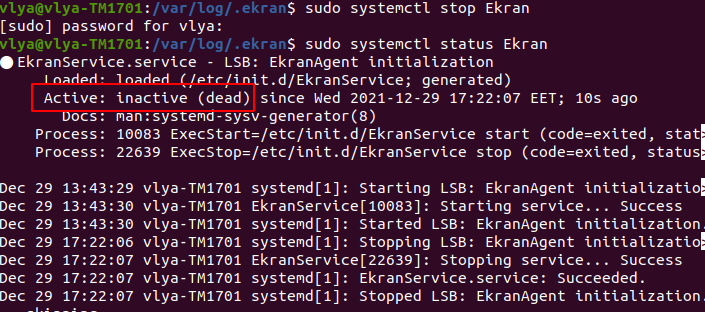How Can I Move the Linux OfflinePool.dat File to Another Folder?
NOT AVAILABLE IN SAAS
Syteca allows you to store offline data in a non-default Linux folder, by making soft links to files containing the offline data.
To configure a non-default folder for offline data (after installing a Linux Client on an endpoint machine), do the following:
1. Unassign the license from the Linux Client (on the Client Management tab) to make sure there are no active (i.e. Live) sessions.
%20-%20BULK%20ACTION%20(SHOP%20and%20ANNOT).png?inst-v=362ca448-a20b-4783-93c2-f49186888f5c)
2. Stop the Ekran services by using the following command: sudo systemctl stop Ekran
(and the following command can then be used to check that the services have stopped: sudo systemctl status Ekran).

3. Stop the offlinePoolManager services by using the following command: sudo systemctl status offlinePoolManager
(and the following command can then be used to check that the services have stopped: sudo systemctl status offlinePoolManager).
4. Open the /var/.ekran/internal/ folder, where the files are located that contain the offline data:
• EkranOfflinePool.dat
• EkranOfflinePool.dat-shm
• EkranOfflinePool.dat-wa

5. Move these files to another location (e.g. NAS system, mounted drive, any another folder, etc) by using the following command: sudo mv EkranOfflinePool.dat* /<Name_of_folder>/
6. Open the folder with the files copied to it, and make soft links for them by using the following commands:
ln -sri EkranOfflinePool.dat /var/.ekran/internal/EkranOfflinePool.dat
ln -sri EkranOfflinePool.dat-shm /var/.ekran/internal/EkranOfflinePool.dat-shm
ln -sri EkranOfflinePool.dat-wal /var/.ekran/internal/EkranOfflinePool.dat-wal
After running these commands, you will see the following result in the /var/.ekran/internal/ folder:

NOTE: In some cases, the owner of these files may need to be changed to the "root" user, which can be done by using the following command: chown -h root:root EkranOfflinePool.dat*
7. Start the Ekran services up again, and check that the Client works correctly by using the following command: sudo systemctl start Ekran

8. Start the offlinePoolManager services up again, and check that the Client works correctly by using the following command: sudo systemctl start offlinePoolManager
9. Re-assign the license to the Linux Client machine (on the Client Management page).
